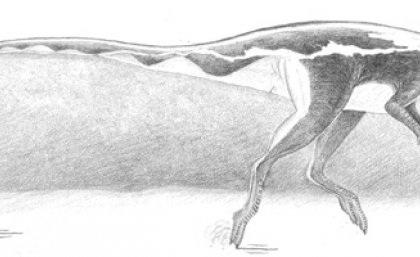
Queensland paleontologists have discovered that the world’s only recorded dinosaur stampede is largely made up of the tracks of swimming rather than running animals.
The University of Queensland’s (UQ) PhD candidate Anthony Romilio led the study of thousands of small dinosaur tracks at Lark Quarry Conservation Park, central-western Queensland.
Mr Romilio says the 95-98 million-year-old tracks are preserved in thin beds of siltstone and sandstone deposited in a shallow river when the area was part of a vast, forested floodplain.
“Many of the tracks are nothing more than elongated grooves, and probably formed when the claws of swimming dinosaurs scratched the river bottom,” Romilio said.
“Some of the more unusual tracks include ‘tippy-toe’ traces – this is where fully buoyed dinosaurs made deep, near vertical scratch marks with their toes as they propelled themselves through the water.
“It’s difficult to see how tracks such as these could have been made by running or walking animals.
“If that was the case we would expect to see a much flatter impression of the foot preserved in the sediment.”
'Skartopus australis' track (3D movie) Romilio et al 2013 from The University of Queensland on Vimeo.
Mr Romilio said that similar looking swim traces made by different sized dinosaurs also indicated fluctuations in the depth of the water.
“The smallest swim traces indicate a minimum water depth of about 14 cm, while much larger ones indicate depths of more than 40 cm,” Mr Romilio said.
“Unless the water level fluctuated, it’s hard to envisage how the different sized swim traces could have been preserved on the one surface.
“Some of the larger tracks are much more consistent with walking animals, and we suspect these dinosaurs were wading through the shallow water.”
Mr Romilio said the swimming dinosaur tracks at Lark Quarry belonged to small, two-legged herbivorous dinosaurs known as ornithopods.
“These were not large dinosaurs,” Mr Romilio said.
“Some of the smaller ones were no larger than chickens, while some of the wading animals were as big as emus.”
The researchers interpreted the large spacing among many consecutive tracks to indicate that the dinosaurs were moving downstream, perhaps using the current of the river to assist their movements.
Given the likely fluctuations in water depth, the researchers assume the tracks were formed over several days, maybe even weeks.
Previous research had identified two types of small dinosaur tracks at Lark Quarry: long-toed tracks (called Skartopus) and short-toed tracks (called Wintonopus).
The UQ scientists found that just like you ‘shouldn’t judge a book by its cover’, you also ‘shouldn’t judge a track by its outline’.
“3D profiles of ‘Skartopus’ tracks reveal that they were made by a short-toed trackmaker dragging its toes through the sediment, thereby elongating the tracks,” explained Romilio.
“In this context, they are best interpreted as a just another variant of Wintonopus.”
Romilio's supervisor and coauthor of the new paper, Dr Steve Salisbury, added that, "3D analysis of the Lark Quarry tracks has allowed us to greatly refine our understanding of what this site represents.
“It is also allowing us to learn more about how these dinosaurs moved and behaved in different environments," Dr Salisbury said.
For the past 30 years, the tracks at Lark Quarry have be known as the world’s only record of a ‘dinosaur stampede’.
Previous research by Romilio and Salisbury in 2011 also showed the larger tracks at Lark Quarry were probably made by a herbivorous dinosaur similar to Muttaburrasaurus, and not a large theropod, as had previously been proposed.
“Taken together, these findings strongly suggest Lark Quarry does not represent a ‘dinosaur stampede’,” Romilio said.
“A better analogy for the site is probably a river crossing.”
Dr Salisbury said regardless of how it was interpreted, these findings took nothing away from the importance of the site.
“Lark Quarry is, and will always remain, one of Australia’s most important dinosaur tracksites,” Dr Salisbury said.
The new study was published in the January 2013 issue of Journal of Vertebrate Paleontology.
More information about dinosaur research at UQ can be found here.
Media: Anthony Romilio, +61 430 514 169; a.romilio@uq.edu.au; Dr Steve Salisbury +61 7 3365 8548 or + 61 407 788 660; s.salisbury@uq.edu.au; Tracey Franchi, UQ School of Biological Sciences Communications Manager, +61 7 3365 4831, t.franchi@uq.edu.au
Images for Publication
Images of the hypothesized dinosaurs thought to be responsible for the Lake Quarry tracks are available for publication. Email UQ Communications at communications@uq.edu.au
Image Caption: Hypothesized reconstruction of the small Lark Quarry trackmaker. Illustration by Anthony Romilio, The University of Queensland.
For Queensland Museum images of Lark Quarry dinosaur tracks and trackways contact Scott Carlile, Image Resource Officer, Publications and Photography, Queensland Museum, +61 7 3842 9241 or scott.carlile@qm.qld.gov.au
About the School of Biological Sciences
Through research undertaken in the School, UQ has been ranked by the 2012 National Taiwan University Rankings in the top five universities globally for research in ecology and environmental biology and in the top 18 universities globally for plant and animal biology. The UQ School of Biological Sciences attracts researchers of world standing in a range of disciplines, with international leaders in many diverse fields. Our work spans the scales of biological organisation, from molecules and cells to organisms, populations, species and communities. With more than 150 researchers working in evolution, global change biology, ecology, aquaculture, animal behaviour, physiology, entomology, zoology, botany, genomics, development and conservation biology, our researchers and graduate scientists are well-equipped to make a real difference in contributing to solving global problems.




